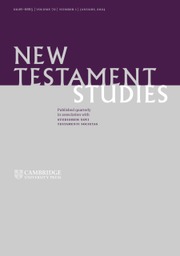 I was pleased to lay my hands on this very recent collection of essays edited by Liv Ingeborg Lied and Marilena Maniaci. It is the third volume in De Gruyter’s new ‘Manuscripta Biblica’ series, edited by Patrick Andrist and Martin Wallraff. (Oddly, vol. 2 is only scheduled for publication in 2019 and there’s no word of vol. 1 on the publisher’s website.) As the series itself indicates, MB focuses on manuscripts of the Bible and as such ‘introduces and analyses these neglected witnesses of acts of reading and re-interpreting the text throughout the centuries’. Bible as Notepad fits squarely within this scope.
I was pleased to lay my hands on this very recent collection of essays edited by Liv Ingeborg Lied and Marilena Maniaci. It is the third volume in De Gruyter’s new ‘Manuscripta Biblica’ series, edited by Patrick Andrist and Martin Wallraff. (Oddly, vol. 2 is only scheduled for publication in 2019 and there’s no word of vol. 1 on the publisher’s website.) As the series itself indicates, MB focuses on manuscripts of the Bible and as such ‘introduces and analyses these neglected witnesses of acts of reading and re-interpreting the text throughout the centuries’. Bible as Notepad fits squarely within this scope.The essays, which are actually proceedings from a 2014 conference held in Oslo, deal with a diverse pool of topics. Here’s the TOC to whet your appetite:
- Liv Ingeborg Lied, ‘Bible as notepad: Exploring annotations and annotation practices in biblical manuscripts’
- Daniel K. Falk, ‘In the margins of the Dead Sea Scrolls’
- Kipp Davis, ‘Margins as media: The long insertion in 4QJera (4Q70)’
- Paolo Buzi, ‘Additional notes in Christian Egyptian biblical manuscripts (fourth–eleventh centuries): Brief remarks’
- Jeff W. Childers, ‘Divining gospel: Classifying manuscripts of John used in sortilege’
- Marilena Maniaci, ‘Written evidence in the Italian Giant Bibles: Around and beyond the sacred text’
- Nurit Pasternak, ‘Giannozzo Manetti’s handwritten notes in his Hebrew Bibles’
- Adam Carter Bremer-McCollum, ‘Notes and colophons of scribes and readers in Georgian biblical manuscripts from Saint Catherine’s Monastery (Sinai)’
- Loren T. Stuckenbruck and Ted M. Erho, ‘EMML 8400 and notes on the reading of Hēnok in Ethiopia’
- Patrick Andrist, ‘Toward a definition of paratexts and paratextuality: The case of ancient Greek manuscripts’

